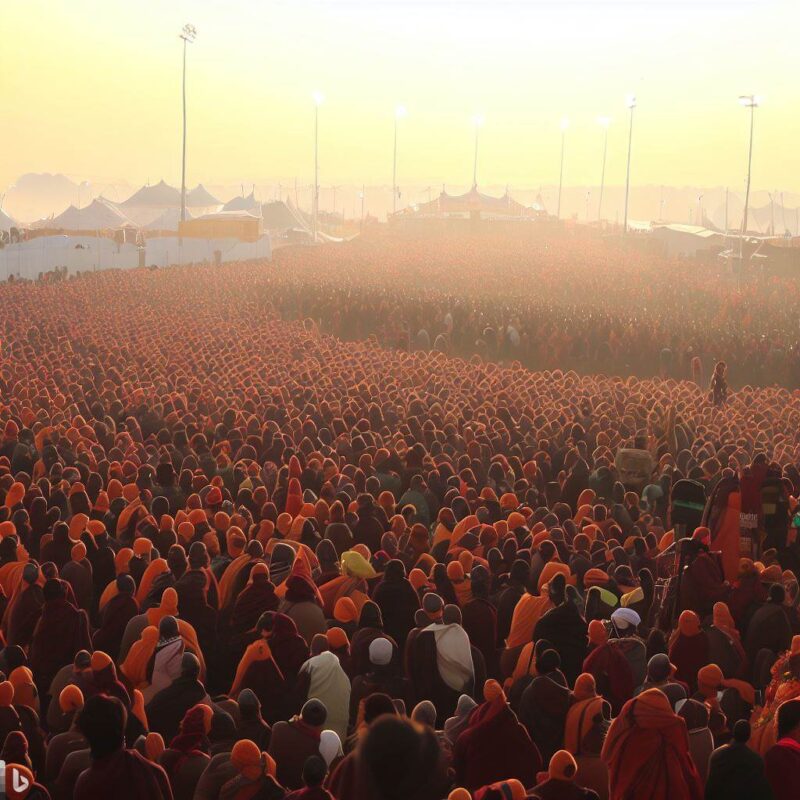The Kumbh Mela, a revered Hindu pilgrimage, is marked by a unique event known as the Shahi Snan, or the Royal Bath. This awe-inspiring gathering of millions of devotees takes place every twelve years at four sacred locations in India: Allahabad (Prayagraj), Haridwar, Nashik, and Ujjain. The Shahi Snan, a grand ritual bath, is the culmination of this spiritual extravaganza, and it holds immense significance in the lives of devout Hindus.
Introduction: The Significance of Kumbh Mela

The Kumbh Mela, one of the world’s largest religious gatherings, is a celebration of spiritual faith and devotion. Held at four different riverbank locations, it attracts millions of pilgrims seeking spiritual rejuvenation and divine blessings.
The Tradition of Shahi Snan: A Historical Perspective
The tradition of Shahi Snan traces back to ancient times when saints and seers believed that taking a dip in the holy river during specific planetary alignments would cleanse them of their sins and lead to salvation.
The Sacred Ritual: Steps of Shahi Snan
The Shahi Snan is a meticulously planned and executed event. It begins with elaborate processions of various akharas (ascetic groups) led by their mahants (spiritual leaders), followed by a ceremonial bath in the river, and culminates with the return processions.
The Spiritual Beliefs: Attaining Purification and Blessings
Devotees believe that the Shahi Snan not only purifies their souls but also bestows blessings, prosperity, and spiritual advancement. The water of the holy rivers is considered to be infused with divine energies during this auspicious event.
Shahi Snan and Astrology: An Auspicious Time
The timing of the Shahi Snan is meticulously calculated based on astrological alignments. Specific planetary positions are believed to enhance the positive effects of the ritual, making it an ideal time for devotees to take the holy plunge.
The Enormous Gathering: Unity in Diversity
The Kumbh Mela is a microcosm of India’s diverse cultural, social, and religious fabric. It brings people from various backgrounds together, fostering a sense of unity and shared spirituality.
Preparations and Arrangements: Managing the Crowds
Organizing an event of this magnitude requires meticulous planning. The local authorities, along with various religious and social organizations, collaborate to manage security, sanitation, healthcare, and other essential services.
The Kumbh Experience: A Transformational Journey
For many, the Kumbh Mela is a life-altering experience. It offers individuals a chance to detach from their material lives, introspect, and strengthen their spiritual connection. The Shahi Snan plays a central role in this transformative journey.
Shahi Snan Amidst Modernity: Balancing Tradition and Technology
While rooted in tradition, the Kumbh Mela has also embraced technology to enhance visitor experience and manage logistics. Mobile apps, real-time crowd monitoring, and digital registrations have streamlined the process.
The Cultural Tapestry: Art, Music, and Discourses
The Kumbh Mela is not just a spiritual event but also a cultural extravaganza. It features vibrant art exhibitions, devotional music performances, and discourses by learned spiritual leaders, enriching the overall experience.
Environmental Concerns: Ensuring Eco-Friendly Celebrations
As the Kumbh Mela attracts millions, concerns about its environmental impact arise. Efforts are being made to ensure eco-friendly practices, waste management, and conservation of the sacred rivers.
Impact on Tourism: Attracting Global Interest
The grandeur of the Kumbh Mela captivates not only pilgrims but also tourists from around the world. Its cultural and spiritual richness makes it a remarkable spectacle that showcases India’s heritage and diversity.
Challenges and Controversies: Navigating Through the Fray
Despite its spiritual significance, the Kumbh Mela is not without challenges. Crowd management, infrastructure development, and occasional controversies test the organizers’ abilities to maintain a smooth event.
Conclusion: A Divine Dip in Faith
The Shahi Snan during the Kumbh Mela is a blend of faith, tradition, spirituality, and unity. It’s a testimony to the profound connection between humanity and the divine, drawing millions to the holy rivers to seek solace, blessings, and a transformative experience.
FAQs
- Is the Kumbh Mela held at the same location every time?
No, the Kumbh Mela rotates between four different locations: Prayagraj, Haridwar, Nashik, and Ujjain. - How often does the Kumbh Mela take place?
The Kumbh Mela occurs every twelve years, with smaller Ardh Kumbh Melas held every six years. - Can non-Hindus participate in the Shahi Snan?
Yes, the Kumbh Mela is open to people of all faiths who seek spiritual experiences. - What is the significance of the different akharas?
Akharas represent various spiritual traditions and sects, each with distinct practices and philosophies. - How is waste management handled during the Kumbh Mela?
Organizers implement extensive waste management systems to minimize the environmental impact and maintain cleanliness.


0 Comment